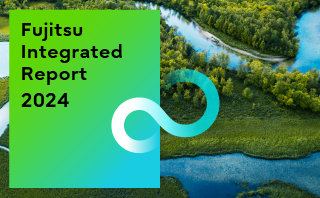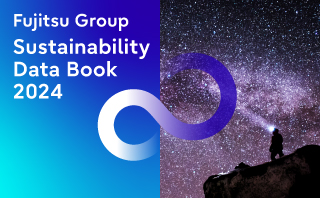-
Sustainability at Fujitsu Group
- Sustainability Management in the Fujitsu Group
- GRB(Global Responsible Business)Goals and Achievments for FY2022
- GRB(Global Responsible Business)Goals for FY2025
- Fujitsu's accessibility
- Stakeholder Engagement
- United Nations Global Compact
- SDG-related Activities in Fujitsu
- External Recognition and Awards
-
Global Responsible Business
- Environment
-
- Environmental Management
- The Fujitsu Group Environmental Vision on Climate Change
- Living in Harmony with Nature (Conservation of Biodiversity)
- Environmental Action Plan
- Environmental Data
- Environmental Communication
- Environmental Social Activities
- Disposal and Recycling of ICT products
- Environmental Considerations in ICT Products
- Governance
-
Data and Documents
- Fujitsu Group Sustainability Data Book 2024
- Social, Governance and Environmental data
- Independent Assurance Report

- GRI Standards / United Nations Global Compact (UNGC) principles Comparison Table
- SASB Standards Comparison Table
- Sustainability Information Disclosure Framework
- Link to regions responsible business reports
- Contact
- Sitemap
Living in Harmony with Nature (Conservation of Biodiversity)
Management Approach
Biodiversity loss poses an enormous global risk; an integrated response is vital to secure a carbon-neutral and nature-positive future
The Global Risks Report 2023 released by the World Economic Forum (WEF), ranks “Biodiversity loss and ecosystem collapse” as the fourth most severe, long-term risk globally, recognizing biodiversity loss alongside climate change as an urgent and critical issue. Viewing the delivery of a nature-positive world as essential to addressing this issue, the G7 Summit held in June 2021 agreed on a G7 2030 Nature Compact, which includes a commitment to “halt and reverse biodiversity loss by 2030”. Part 2 of the 15th Conference of the Parties to the UN Convention on Biological Diversity (CBD-COP15) held in December 2022 adopted the Kunming-Montreal Global Biodiversity Framework, which includes international targets for 2030. The framework establishes “23 Global Targets for 2030” aimed at the 2030 Mission “To take urgent action to halt and reverse biodiversity loss to put nature on a path to recovery for the benefit of people and planet” (excerpt). Business groups such as the World Business Council for Sustainable Development (WBCSD) and international environmental NGOs such as the World Wide Fund for Nature (WWF) have also announced a joint proposal with a target of achieving a nature-positive planet by 2030. Thus, it is now considered vital that we not only have carbon-neutral initiatives to counter climate change, but also integrated measures aimed at delivering nature-positive outcomes.
To deliver nature-positive outcomes, we have established a vision and a mid-term goal in line with international targets
Committed to delivering nature-positive outcomes, in 2022 the Fujitsu Group formulated its vision for 2050, its 2030 Mid-term Target, and its 2025 Short-term Target (Environmental Action Plan Stage XI) in line with international targets (Kunming-Montreal Global Biodiversity Framework).
Vision for 2050: Create a world in harmony with nature, where "nature and biodiversity," which are fundamental to a sustainable society, are fully restored through digital technology.
2030 Mid-term Target: Reduce negative impacts on biodiversity by at least 25% (Base year : FY2020) in the area of company's corporate activities, including supply chain, and promote activities to increase positive impacts on it..
2025 Short-term Target: Reduce negative impacts on biodiversity by at least 12.5% (Base year : FY2020) in the area of company's corporate activities, including supply chain, and promote activities to increase positive impacts on it.
We will continue to implement activities to reduce negative impacts and increase positive impacts on biodiversity.
FY2023 Results
| Target Under Stage XI of the Fujitsu Group Environmental Action Plan | FY2023 result |
|---|---|
| Reduce negative impacts on biodiversity by at least 12.5% (Base year : FY2020) in the area of company's corporate activities, including supply chain, and promote activities to increase positive impacts on it. | Negative impacts on biodiversity were reduced by 27.5% (Base year: FY2020) in locations where Group and supply chain activities are located.
As one of Fujitsu Group activities to increase our positive impact on biodiversity, the Fujitsu Numazu Plant has been certified by the Ministry of the Environment as a Nationally Certified Sustainably Managed Natural Sites, contributing to the achievement of the 30 by 30 target. |
Establishment of a calculation method that uses Ecological Footprint (EF) as the indicator for visualizing the impact of corporate activities on biodiversity
Of the Global Targets for 2030 established by the Kunming-Montreal Global Biodiversity Framework adopted at CBD-COP15, one of the most relevant targets to the business sector is Target 15: ” Take legal, administrative or policy measures to encourage and enable business, and in particular to ensure that large and transnational companies and financial institutions:
(a) Regularly monitor, assess, and transparently disclose their risks, dependencies and impacts on biodiversity, including with requirements for all large as well as transnational companies and financial institutions along their operations, supply and value chains, and portfolios;
(b) Provide information needed to consumers to promote sustainable consumption patterns;
(c) Report on compliance with access and benefit-sharing regulations and measures, as applicable;
in order to progressively reduce negative impacts on biodiversity, increase positive impacts, reduce biodiversity-related risks to business and financial institutions, and promote actions to ensure sustainable patterns of production.”
At the 24th meeting of the Subsidiary Body on Scientific, Technical and Technological Advice (SBSTTA-24), assessment indicators for each target were also discussed and Ecological Footprint was proposed as one of the candidate indicators for Target 15.
In response, the Fujitsu Group established a calculation method that uses the Ecological Footprint indicator to enable a comprehensive evaluation of the organization’s activities. Selected to measure negative impacts on biodiversity, the method identified significant negative-impact factors in the Ecological Footprint assessment of the Group's activities. See below for details.
The Fujitsu Group selected Ecological Footprint as an evaluation indicator for the following reasons:
- ①Ecological Footprint is a Component indicator for Target 15 of the Global Targets for 2030, proposed by SBSTTA-24, selected based on scientific findings.
- ②It enables comprehensive evaluation of all corporate activities.
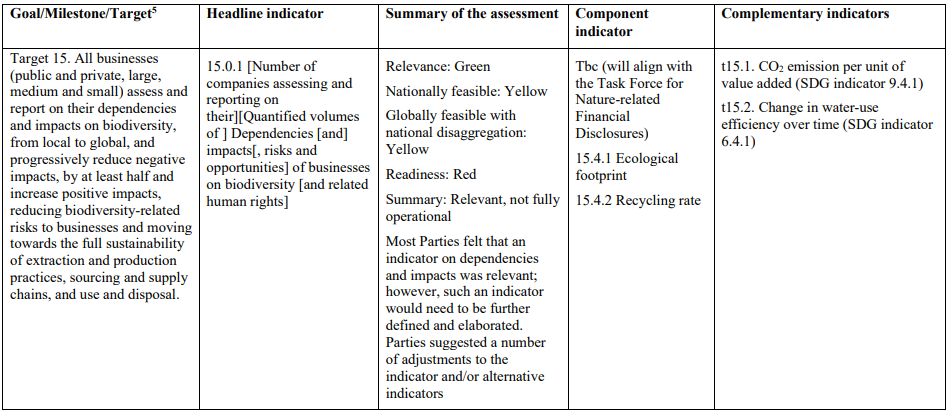 CO-CHAIRS’ SUMMARY AND PROPOSED LIST OF INDICATORS FOR CONSIDERATION IN DEVELOPING THE MONITORING FRAMEWORK FOR THE POST-2020 GLOBAL BIODIVERSITY FRAMEWORKSource: CBD/SBSTTA/REC/24/2, March 27, 2022
CO-CHAIRS’ SUMMARY AND PROPOSED LIST OF INDICATORS FOR CONSIDERATION IN DEVELOPING THE MONITORING FRAMEWORK FOR THE POST-2020 GLOBAL BIODIVERSITY FRAMEWORKSource: CBD/SBSTTA/REC/24/2, March 27, 2022
In examining the calculation method, we used the Business & Biodiversity Interrelationship Map® (developed by Japan Business Initiative for Biodiversity (JBIB)) as the basis for extracting items that have biodiversity-related dependencies and impacts, and determined the corresponding amount of activity for each item, as set out in the following table:
| Life Cycle | Nature-related Dependency | Nature-related Impact | Impact Driver | Activity Amount |
|---|---|---|---|---|
| Procurement | Consumption of raw materials | ― | Resource use/replenishment | Amount of resources used (biotic, abiotic) |
| ― | Emissions released into the atmosphere | Climate change | Amount of CO2 emitted | |
| Design & Development / Manufacturing | Consumption of water resources | ― | Resource use/replenishment | Amount of water used |
| Consumption of chemical substances | ― | Resource use/replenishment | Amount of PRTR, VOC handled | |
| Consumption of energy | ― | Resource use/replenishment | Amount of electricity purchased | |
| Amount of heavy oil Type A used | ||||
| Amount of kerosene used | ||||
| Amount of gasoline used | ||||
| Amount of light oil used | ||||
| Amount of natural gas used | ||||
| Amount of city gas used | ||||
| Amount of LPG used | ||||
| Amount of LNG used | ||||
| Amount of district heating and cooling supply used | ||||
| ― | Emissions released into the atmosphere | Climate change | Amount of CO2 emitted | |
| Pollution/pollution removal | Amount of NOx, SOx emitted | |||
| Amount of PRTR, VOC emitted | ||||
| Amount of waste incinerated | ||||
| ― | Discharge into water bodies | Pollution/pollution removal | Amount of BOD, COD emitted | |
| Amount of PRTR emitted | ||||
| ― | Discharge into the ground | Pollution/pollution removal | Amount of waste to landfill | |
| Logistics & Sales | Consumption of energy | ― | Resource use/replenishment | Amount of energy consumed |
| ― | Emissions released into the atmosphere | Climate change | Amount of CO2 emitted | |
| Use | ― | Emissions released into the atmosphere | Climate change | Amount of CO2 emitted |
| Other | ― | Land used for business | Land/ freshwater/ocean use change | Business site area |
We then established an Ecological Footprint (EF) calculation method, using the above Activity Amount items as inputs. We used life cycle inventory (LCI) data to convert some Activity Amount items (e.g., Amount of resources used) to Corporate Activity items that correspond to EF coefficients. Where a Corporate Activity item (e.g., Use of water resources) cannot directly use an EF coefficient, this is reflected in the EF calculation by using additional conversion logic based on scientific knowledge to expand on the original EF method.
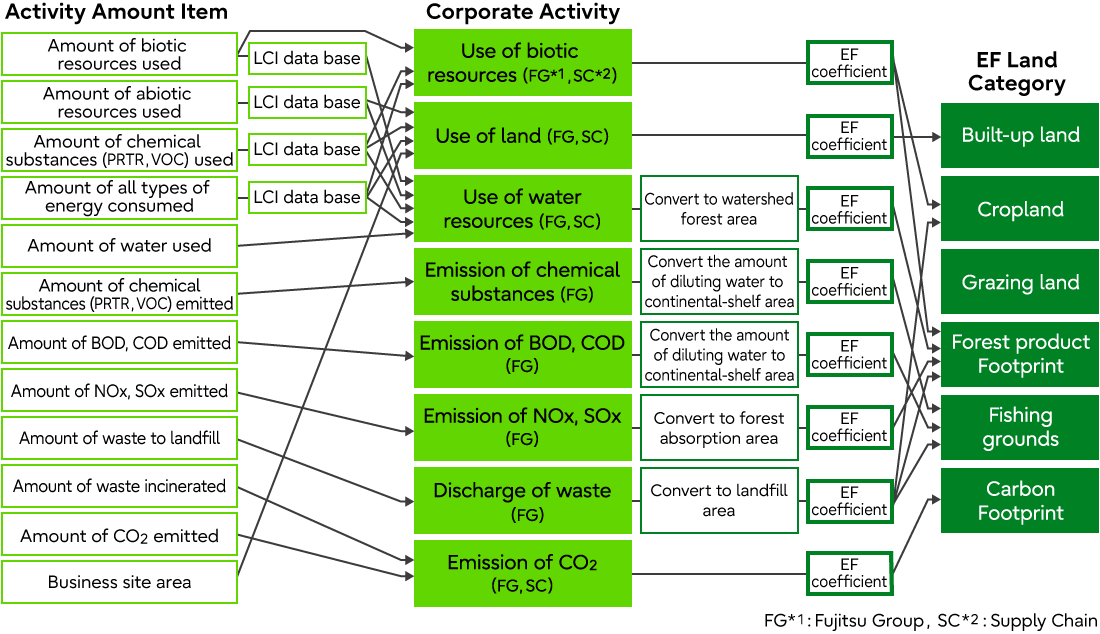 Integrated Assessment of Corporate Activities by Ecological Footprint (EF) in the Fujitsu Group
Integrated Assessment of Corporate Activities by Ecological Footprint (EF) in the Fujitsu Group
The results of our EF assessment of the Group's corporate activities show that Emission of CO2 from the Group and its supply chain activities together account for 92% of the negative-impact factors. Water resource use accounts for the remaining 8%, but we found that this was mainly attributable to energy use. We established that Emission of CO2 and energy use together account for 99% of the negative-impact factors. This means that activities aimed at reducing GHG emissions, such as energy conservation and the introduction of renewables, can also reduce our Ecological Footprint. In short, this clearly demonstrates that the Group’s climate change measures are proving effective in reducing negative impacts on biodiversity.
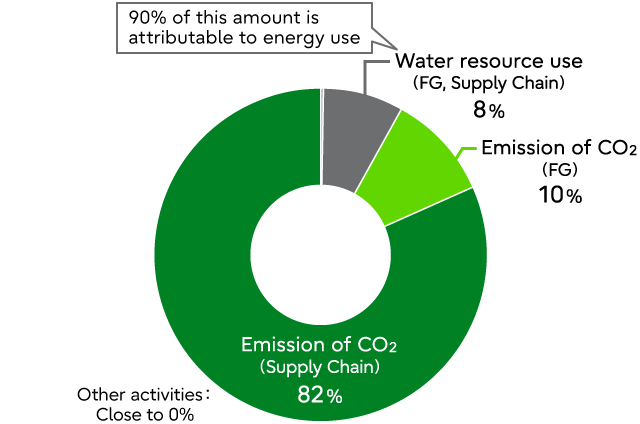 EF Calculation Results in Fujitsu Group (FY2020) - Percentage by Corporate Activity -
EF Calculation Results in Fujitsu Group (FY2020) - Percentage by Corporate Activity -FY2023 Initiatives in Detail
27.5% reduction (FY2020 baseline) in negative impacts on biodiversity in the supply chain and locations in which the Group operates
As a result of using the Ecological Footprint as an indicator for assessing impacts in the supply chain and locations in which the Group operates, we have reduced the negative impact on biodiversity by 27.5% against a baseline of FY2020, thus achieving our FY2023 target of a reduction of at least 7.5% against a baseline of FY2020 (*1). This is due to a reduction in CO2 emissions, notably a significant reduction in CO2 emissions downstream in the supply chain (Scope 3 Category 11 emissions).
- *1EF coefficients are fixed for comparison
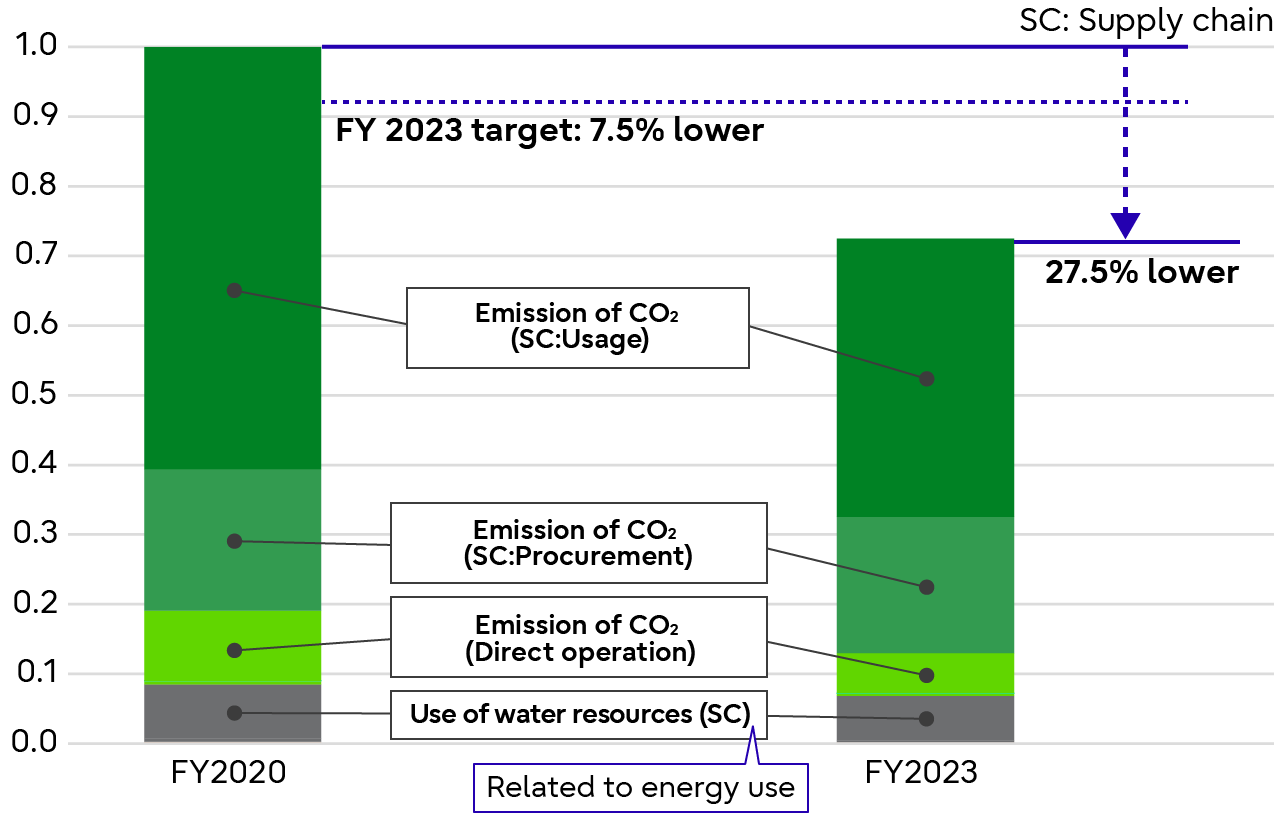 Fujitsu Group EF Assessment (FY2023 Results, by Corporate Activity)
Fujitsu Group EF Assessment (FY2023 Results, by Corporate Activity)
One of our activities aimed at increasing our positive impact on biodiversity and contributing to the achievement of the 30by30 target involves the Fujitsu Numazu Plant, now certified by the Ministry of the Environment as a Nationally Certified Sustainably Managed Natural Sites
Just under 80% of the approximately 53 ha site occupied by the Fujitsu Numazu Plant is given over to green space to nurture the precious biodiversity of the region. The Numazu Plant manages the green space with the aim of preserving the natural environment, maintaining the landscape, and providing a place for employees and local residents to learn about the natural environment. In 2023, the Numazu Plant Green Conservation Area was certified by the Ministry of the Environment as a Nationally Certified Sustainably Managed Natural Sites.
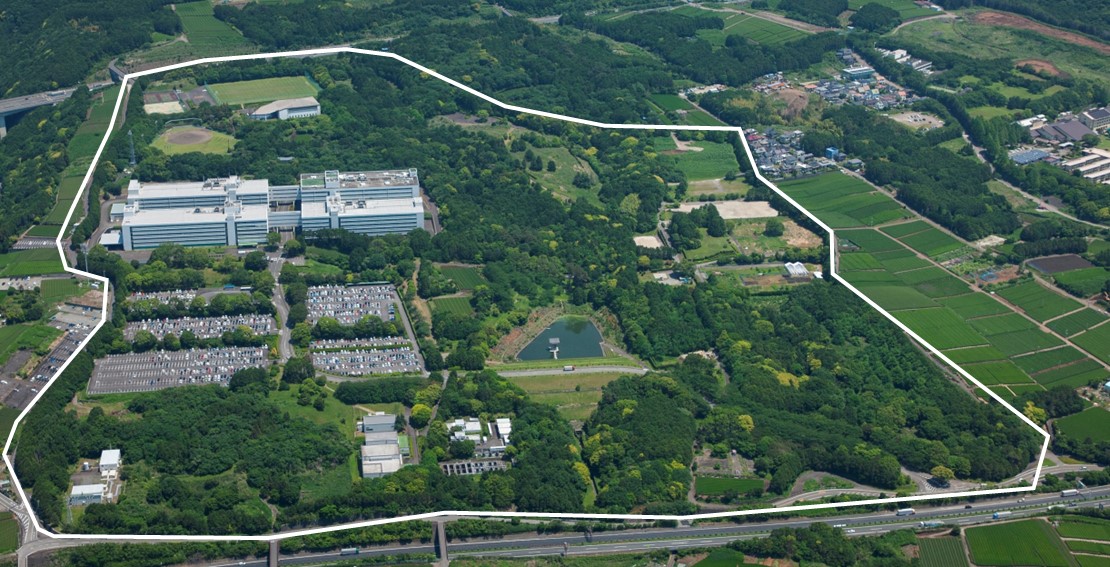 Fujitsu Numazu Plant Green Conservation Area (certified by the Ministry of the Environment as a Nationally Certified Sustainably Managed Natural Sites)
Fujitsu Numazu Plant Green Conservation Area (certified by the Ministry of the Environment as a Nationally Certified Sustainably Managed Natural Sites)
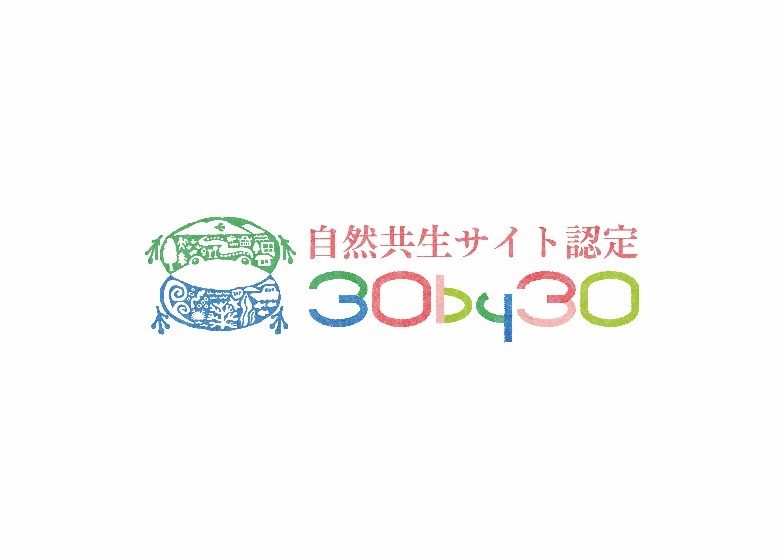 Certification logo: Nationally Certified Sustainably Managed Natural Sites
Certification logo: Nationally Certified Sustainably Managed Natural Sites

